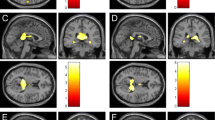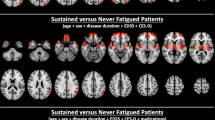Abstract
Fatigue in multiple sclerosis (MS) occurs commonly, sometimes as the earliest symptom. Some MS patients consider fatigue to be their most troublesome complaint, and it has been shown to be an independent predictor of impaired quality of life. Several reports have demonstrated that subcortical gray matter pathology is related to fatigue. We hypothesized that MRI detectable changes in the deep gray matter of MS patients may correlate with fatigue severity.
Our objective was: to assess the relationship between fatigue severity and detectable changes on magnetic resonance imaging (MRI), quantified using the mean T1 relaxation time (T1), in deep gray matter structures in relapsingremitting multiple sclerosis (RRMS). Using region of interest analysis, T1 values were measured for the thalamus, putamen and caudate nucleus in 52 RRMS patients and 19 healthy volunteers. Fatigue was assessed using the Fatigue Severity Scale. Results: The median T1 in the thalamus and the putamen were significantly higher in the patient cohort than in the healthy controls; the median T1 in the caudate was also higher in the MS patients but did not reach statistical significance. There was a significant correlation between fatigue severity and the T1 of the thalamus (rho = 0.418; p = 0.014). Furthermore, the median T1 in the thalamus was significantly higher in patients with fatigue compared with those without (p = 0.018). Our results provide further evidence for the role of subcortical gray matter structures in the pathogenesis of multiple sclerosis (MS)–related fatigue. This study also demonstrates that T1 relaxation time measurement is a suitable technique for detecting abnormalities of the deep gray matter in RRMS and presents further support of gray matter involvement in MS.
Similar content being viewed by others
References
MSCfCP Guidelines (1998) Fatigue and multiple sclerosis: evidence–based management strategies for fatigue in multiple sclerosis In:Multiple Sclerosis Council for Clinical Practice Guidelines, Washington, DC
Janardhan V, Bakshi R (2002) Quality of life in patients with multiple sclerosis: the impact of fatigue and depression. J Neurol Sci 205:51–58
Freal JE, Kraft GH, Coryell JK (1984) Symptomatic fatigue in multiple sclerosis. Arch Phys Med Rehabil 65:135–138
Krupp LB, Alvarez LA, LaRocca NG, Scheinberg LC (1988) Fatigue in multiple sclerosis. Arch Neurol 45:435–437
Miller RG, Green AT, Moussavi RS, Carson PJ, Weiner MW (1990) Excessive muscular fatigue in patients with spastic paraparesis. Neurology 40:1271–1274
Sheean GL, Murray NM, Rothwell JC, Miller DH, Thompson AJ (1997) An electrophysiological study of the mechanism of fatigue in multiple sclerosis. Brain 120(Pt 2):299–315
Tartaglia MC, Narayanan S, Francis SJ, Santos AC, De Stefano N, Lapierre Y, Arnold DL (2004) The relationship between diffuse axonal damage and fatigue in multiple sclerosis. Arch Neurol 61:201–207
Roelcke U, Kappos L, Lechner–Scott J, Brunnschweiler H, Huber S, Ammann W, Plohmann A, Dellas S, Maguire RP, Missimer J, Radu EW, Steck A, Leenders KL (1997) Reduced glucose metabolism in the frontal cortex and basal ganglia of multiple sclerosis patients with fatigue: a 18F–fluorodeoxyglucose positron emission tomography study. Neurology 48:1566–1571
Filippi M, Rocca MA, Colombo B, Falini A, Codella M, Scotti G, Comi G (2002) Functional magnetic resonance imaging correlates of fatigue in multiple sclerosis. Neuroimage 15:559–567
Codella M, Rocca MA, Colombo B, Martinelli–Boneschi F, Comi G, Filippi M (2002) Cerebral grey matter pathology and fatigue in patients with multiple sclerosis: a preliminary study. J Neurol Sci 194:71–74
Colombo B, Martinelli Boneschi F, Rossi P, Rovaris M, Maderna L, Filippi M, Comi G (2000) MRI and motor evoked potential findings in nondisabled multiple sclerosis patients with and without symptoms of fatigue. J Neurol 247:506–509
Bakshi R, Miletich RS, Henschel K, Shaikh ZA, Janardhan V, Wasay M, Stengel LM, Ekes R, Kinkel PR (1999) Fatigue in multiple sclerosis: crosssectional correlation with brain MRI findings in 71 patients. Neurology 53:1151–1153
Truyen L, van Waesberghe JH, van Walderveen MA, van Oosten BW, Polman CH, Hommes OR, Ader HJ, Barkhof F (1996) Accumulation of hypointense lesions (“black holes”) on T1 spin–echo MRI correlates with disease progression in multiple sclerosis. Neurology 47:1469–1476
van Walderveen MA, Barkhof F, Pouwels PJ, van Schijndel RA, Polman CH, Castelijns JA (1999) Neuronal damage in T1–hypointense multiple sclerosis lesions demonstrated in vivo using proton magnetic resonance spectroscopy. Ann Neurol 46:79–87
Parry A, Clare S, Jenkinson M, Smith S, Palace J, Matthews PM (2002) White matter and lesion T1 relaxation times increase in parallel and correlate with disability in multiple sclerosis. J Neurol 249:1279–1286
Griffin CM, Chard DT, Parker GJ, Barker GJ, Thompson AJ, Miller DH (2002) The relationship between lesion and normal appearing brain tissue abnormalities in early relapsing remitting multiple sclerosis. J Neurol 249:193–199
van Walderveen MA, van Schijndel RA, Pouwels PJ, Polman CH, Barkhof F (2003) Multislice T1 relaxation time measurements in the brain using IREPI: reproducibility, normal values, and histogram analysis in patients with multiple sclerosis. J Magn Reson Imaging 18:656–664
van Waesberghe JH, Castelijns JA, Scheltens P, Truyen L, Lycklana ANGJ, Hoogenraad FG, Polman CH, Valk J, Barkhof F (1997) Comparison of four potential MR parameters for severe tissue destruction in multiple sclerosis lesions. Magn Reson Imaging 15:155–162
Vaithianathar L, Tench CR, Morgan PS, Constantinescu CS (2003) Magnetic resonance imaging of the cervical spinal cord in multiple sclerosis – a quantitative T1 relaxation time mapping approach. J Neurol 250:307–315
Vaithianathar L, Tench CR, Morgan PS, Wilson M, Blumhardt LD (2002) T1 relaxation time mapping of white matter tracts in multiple sclerosis defined by diffusion tensor imaging. J Neurol 249:1272–1278
Morgan PS, Moody AR, Tench CR, Vaithianathar L (2001) Rapid 3D T1 mapping ISMRM, Glasgow, UK 898
Lublin FD, Reingold SC (1996) Defining the clinical course of multiple sclerosis: results of an international survey. National Multiple Sclerosis Society (USA) Advisory Committee on Clinical Trials of New Agents in Multiple Sclerosis. Neurology 46:907–911
McDonald WI, Compston A, Edan G, Goodkin D, Hartung HP, Lublin FD, McFarland HF, Paty DW, Polman CH, Reingold SC, Sandberg–Wollheim M, Sibley W, Thompson A, van den Noort S, Weinshenker BY, Wolinsky JS (2001) Recommended diagnostic criteria for multiple sclerosis: guidelines from the International Panel on the diagnosis of multiple sclerosis. Ann Neurol 50:121–127
Kurtzke J (1984) Disability rating scales in multiple sclerosis. Ann NY Acad Sci 436:347–360
Krupp LB, LaRocca NG, Muir–Nash J, Steinberg AD (1989) The fatigue severity scale. Application to patients with multiple sclerosis and systemic lupus erythematosus. Arch Neurol 46:1121–1123
Sonka M, Hlavac V, Boyle R (1998) Image Processing, Analysis and Machine Vision. Brooks and Cole Publishing, California
Cifelli A, Arridge M, Jezzard P, Esiri MM, Palace J, Matthews PM (2002) Thalamic neurodegeneration in multiple sclerosis. Ann Neurol 52:650–653
Wylezinska M, Cifelli A, Jezzard P, Palace J, Alecci M, Matthews PM (2003) Thalamic neurodegeneration in relapsing– remitting multiple sclerosis. Neurology 60:1949–1954
Davies GR, Altmann DR, Rashid W, Chard DT, Griffin CM, Barker GJ, Kapoor R, Thompson AJ, Miller DH (2005) Emergence of thalamic magnetization transfer ratio abnormality in early relapsing–remitting multiple sclerosis. Mult Scler 11:276–281
Carone DA, Benedict RH, Dwyer MG, Cookfair DL, Srinivasaraghavan B, Tjoa CW, Zivadinov R (2006) Semiautomatic brain region extraction (SABRE) reveals superior cortical and deep gray matter atrophy in MS. Neuroimage 29:505–514
Barnes D, McDonald WI, Landon DN, Johnson G (1988) The characterization of experimental gliosis by quantitative nuclear magnetic resonance imaging. Brain 111(Pt 1):83–94
Barnes D, McDonald WI, Johnson G, Tofts PS, Landon DN (1987) Quantitative nuclear magnetic resonance imaging: characterisation of experimental cerebral oedema. J Neurol Neurosurg Psychiatry 50:125–133
van Waesberghe JH, Kamphorst W, De Groot CJ, van Walderveen MA, Castelijns JA, Ravid R, Lycklama a Nijeholt GJ, van der Valk P, Polman CH, Thompson AJ, Barkhof F (1999) Axonal loss in multiple sclerosis lesions: magnetic resonance imaging insights into substrates of disability. Ann Neurol 46:747–754
Brownell B, Hughes JT (1962) The distribution of plaques in the cerebrum in multiple sclerosis. J Neurol Neurosurg Psychiatry 25:315–320
Huitinga I, De Groot CJ, Van der Valk P, Kamphorst W, Tilders FJ, Swaab DF (2001) Hypothalamic lesions in multiple sclerosis. J Neuropathol Exp Neurol 60:1208–1218
Peterson JW, Bo L, Mork S, Chang A, Trapp BD (2001) Transected neurites, apoptotic neurons, and reduced inflammation in cortical multiple sclerosis lesions. Ann Neurol 50:389–400
Sawlani V, Gupta RK, Singh MK, Kohli A (1997) MRI demonstration of Wallerian degeneration in various intracranial lesions and its clinical implications. J Neurol Sci 146:103–108
Simon JH, Kinkel RP, Jacobs L, Bub L, Simonian N (2000) A Wallerian degeneration pattern in patients at risk for MS. Neurology 54:1155–1160
Cookfair DL, Fischer J, Rudick R, Jacobs L, Herndon R, Richert J, Granger C, Simon J, Goodkin D (1997) Fatigue severity in low disability MS patients participating in a phase III trial of Avonex (IFNb–1a) for relapsing multiple sclerosis. Neurology 48(Suppl 2):A173 (Abstract)
Mainero C, Faroni J, Gasperini C, Filippi M, Giugni E, Ciccarelli O, Rovaris M, Bastianello S, Comi G, Pozzilli C (1999) Fatigue and magnetic resonance imaging activity in multiple sclerosis. J Neurol 246:454–458
Bruno RL, Creange SJ, Frick NM (1998) Parallels between post–polio fatigue and chronic fatigue syndrome: a common pathophysiology? Am J Med 105:66S–73S
Schuurman PR, Bosch DA, Bossuyt PM, Bonsel GJ, van Someren EJ, de Bie RM, Merkus MP, Speelman JD (2000) A comparison of continuous thalamic stimulation and thalamotomy for suppression of severe tremor. N Engl J Med 342:461–468
Hua Z, Guodong G, Qinchuan L, Yaqun Z, Qinfen W, Xuelian W (2003) Analysis of complications of radiofrequency pallidotomy. Neurosurgery 52:89–101
Bhatia KP, Marsden CD (1994) The behavioural and motor consequences of focal lesions of the basal ganglia in man. Brain 117(Pt 4):859–876
Author information
Authors and Affiliations
Corresponding author
Additional information
Dr. Niepel and Dr. Tench contributed equally to this article.
Rights and permissions
About this article
Cite this article
Niepel, G., Tench, C.R., Morgan, P.S. et al. Deep gray matter and fatigue in MS. J Neurol 253, 896–902 (2006). https://doi.org/10.1007/s00415-006-0128-9
Received:
Revised:
Accepted:
Published:
Issue Date:
DOI: https://doi.org/10.1007/s00415-006-0128-9




